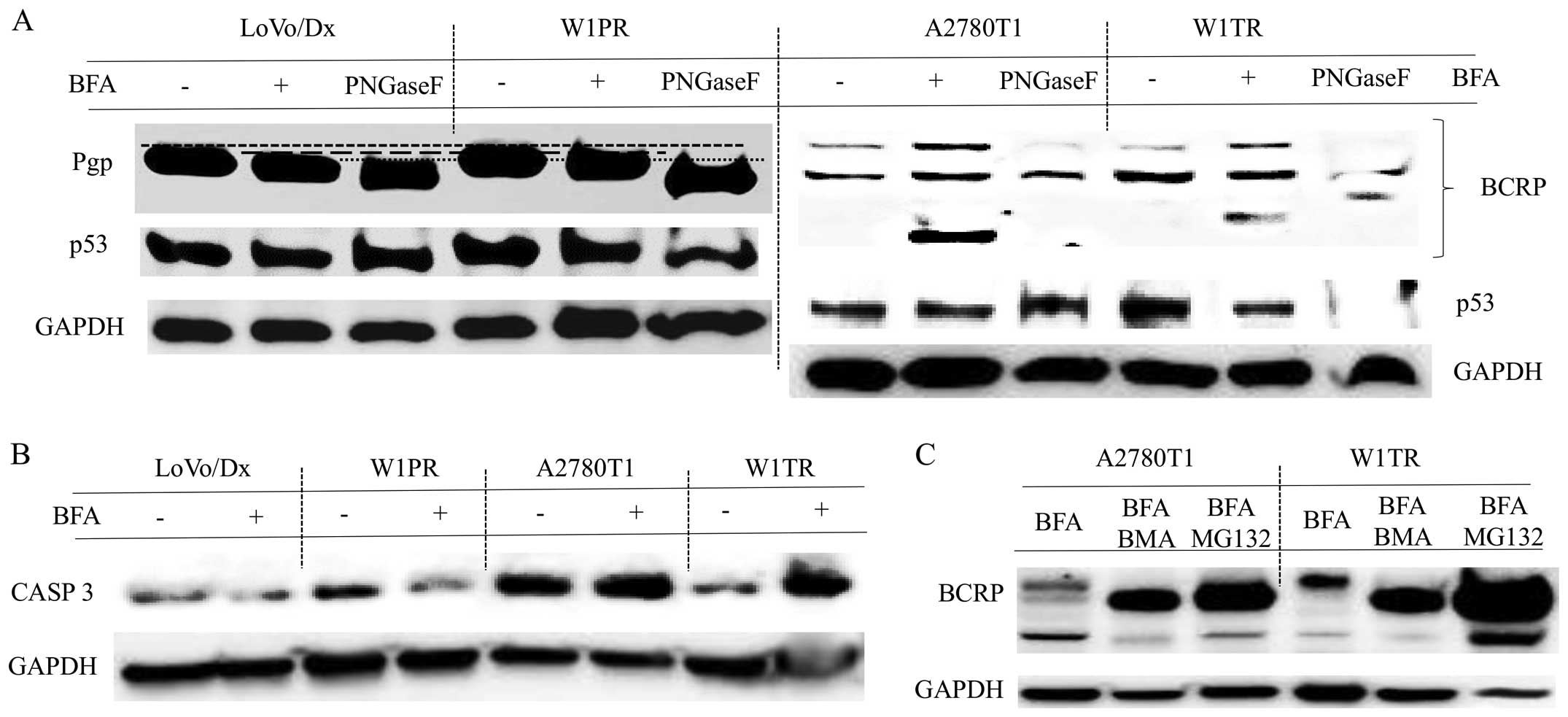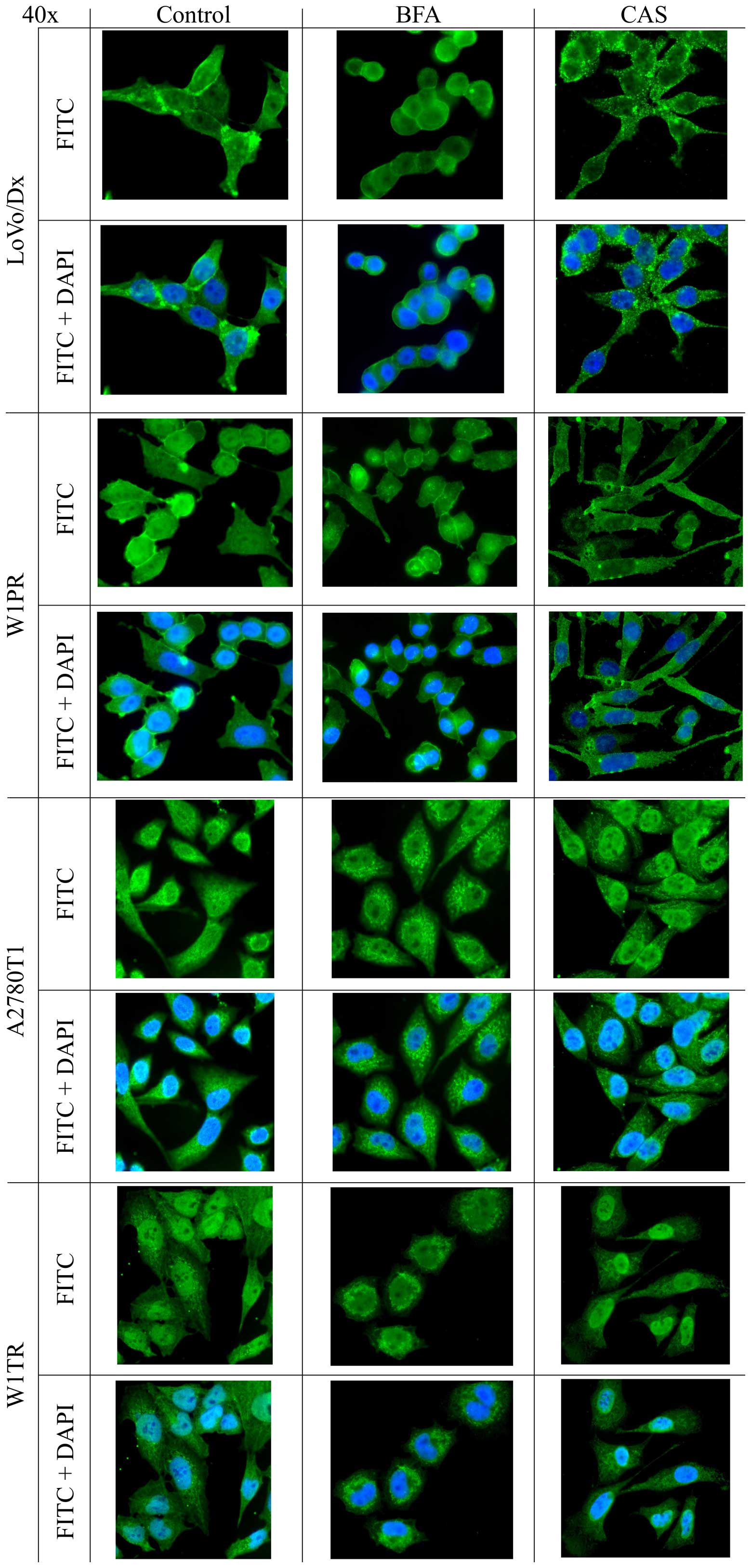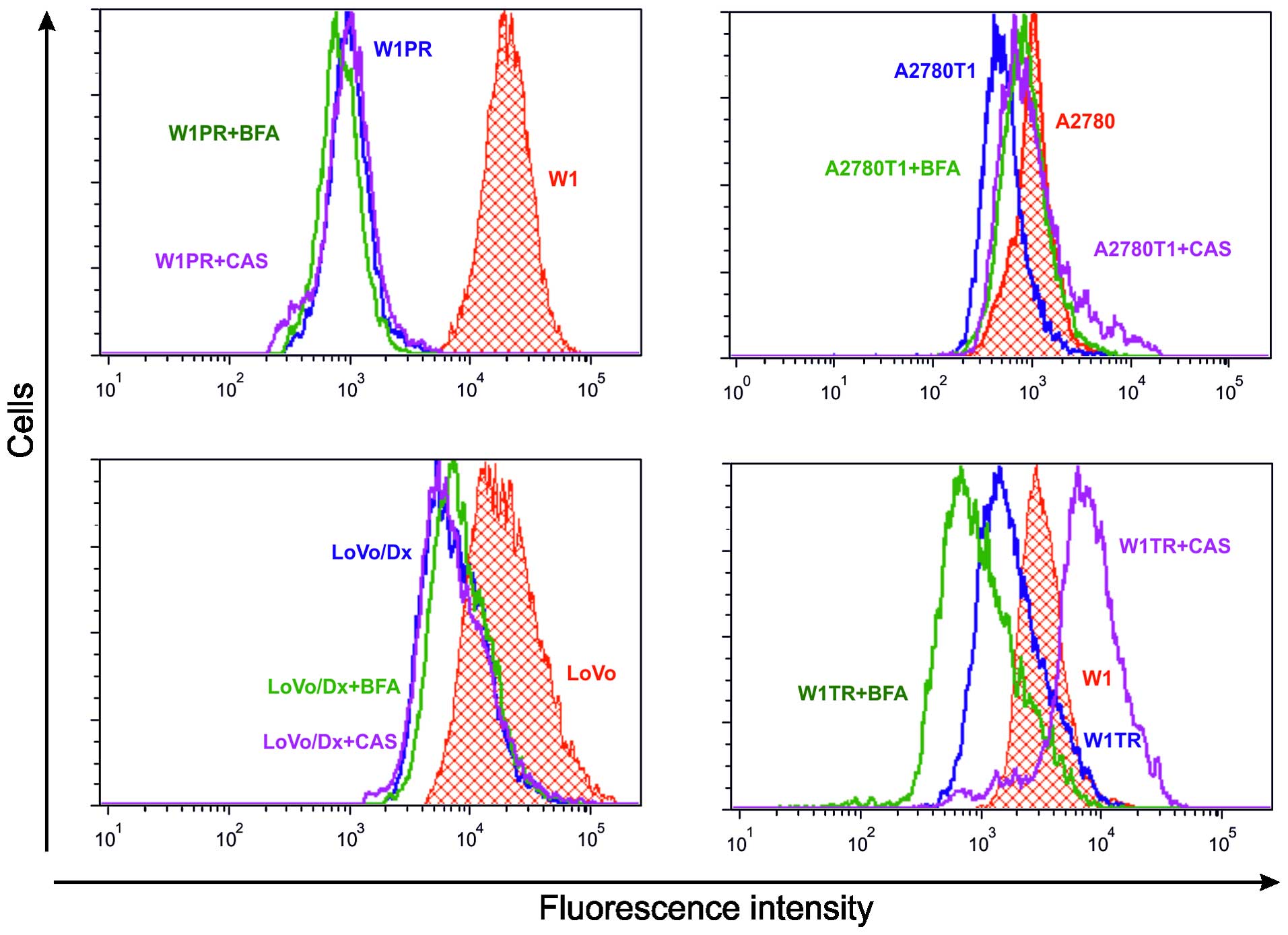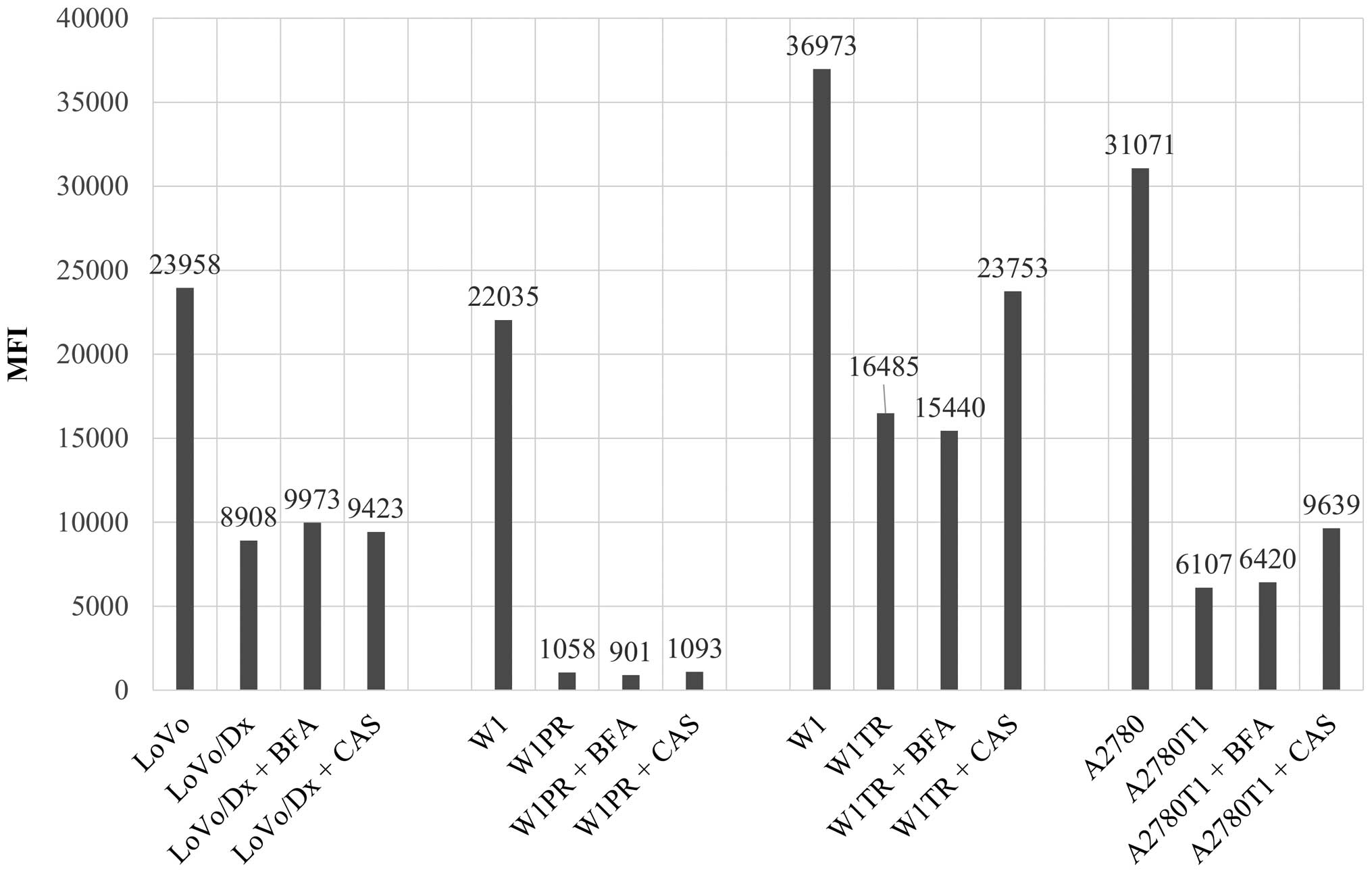|
1
|
Christiansen MN, Chik J, Lee L, Anugraham
M, Abrahams JL and Packer NH: Cell surface protein glycosylation in
cancer. Proteomics. 14:525–546. 2014. View Article : Google Scholar
|
|
2
|
Persidis A: Cancer multidrug resistance.
Nat Biotechnol. 18(Suppl): IT18–IT20. 2000.
|
|
3
|
Sharom FJ: ABC multidrug transporters:
Structure, function and role in chemoresistance. Pharmacogenomics.
9:105–127. 2008. View Article : Google Scholar
|
|
4
|
Ma H, Miao X, Ma Q, Zheng W, Zhou H and
Jia L: Functional roles of glycogene and n-glycan in multidrug
resistance of human breast cancer cells. IUBMB Life. 65:409–422.
2013. View Article : Google Scholar : PubMed/NCBI
|
|
5
|
Li K, Sun Z, Zheng J, Lu Y, Bian Y, Ye M,
Wang X, Nie Y, Zou H and Fan D: In-depth research of multidrug
resistance related cell surface glycoproteome in gastric cancer. J
Proteomics. 82:130–140. 2013. View Article : Google Scholar : PubMed/NCBI
|
|
6
|
Meschini S, Calcabrini A, Monti E, Del
Bufalo D, Stringaro A, Dolfini E and Arancia G: Intracellular
P-glycoprotein expression is associated with the intrinsic
multidrug resistance phenotype in human colon adenocarcinoma cells.
Int J Cancer. 87:615–628. 2000. View Article : Google Scholar : PubMed/NCBI
|
|
7
|
Pastan I and Gottesman M: Multiple-drug
resistance in human cancer. N Engl J Med. 316:1388–1393. 1987.
View Article : Google Scholar : PubMed/NCBI
|
|
8
|
Wojtowicz K, Szaflarski W, Januchowski R,
Zawierucha P, Nowicki M and Zabel M: Inhibitors of N-glycosylation
as a potential tool for analysis of the mechanism of action and
cellular localisation of glycoprotein P. Acta Biochim Pol.
59:445–450. 2012.PubMed/NCBI
|
|
9
|
Shapiro AB, Fox K, Lee P, Yang YD and Ling
V: Functional intracellular P-glycoprotein. Int J Cancer.
76:857–864. 1998. View Article : Google Scholar : PubMed/NCBI
|
|
10
|
Baldini N, Scotlandi K, Serra M, Shikita
T, Zini N, Ognibene A, Santi S, Ferracini R and Maraldi NM: Nuclear
immunolocalization of P-glycoprotein in multidrug-resistant cell
lines showing similar mechanisms of doxorubicin distribution. Eur J
Cell Biol. 68:226–239. 1995.PubMed/NCBI
|
|
11
|
Calcabrini A, Meschini S, Stringaro A,
Cianfriglia M, Arancia G and Molinari A: Detection of
P-glycoprotein in the nuclear envelope of multidrug resistant
cells. Histochem J. 32:599–606. 2000. View Article : Google Scholar
|
|
12
|
Noguchi K, Katayama K and Sugimoto Y:
Human ABC transporter ABCG2/BCRP expression in chemoresistance:
Basic and clinical perspectives for molecular cancer therapeutics.
Pharm Genomics Pers Med. 7:53–64. 2014.
|
|
13
|
Nakanishi T and Ross DD: Breast cancer
resistance protein (BCRP/ABCG2): Its role in multidrug resistance
and regulation of its gene expression. Chin J Cancer. 31:73–99.
2012. View Article : Google Scholar
|
|
14
|
Wakabayashi-Nakao K, Tamura A, Furukawa T,
Nakagawa H and Ishikawa T: Quality control of human ABCG2 protein
in the endoplasmic reticulum: Ubiquitination and proteasomal
degradation. Adv Drug Deliv Rev. 61:66–72. 2009. View Article : Google Scholar
|
|
15
|
Nakagawa H, Wakabayashi-Nakao K, Tamura A,
Toyoda Y, Koshiba S and Ishikawa T: Disruption of N-linked
glycosylation enhances ubiquitin-mediated proteasomal degradation
of the human ATP-binding cassette transporter ABCG2. FEBS J.
276:7237–7252. 2009. View Article : Google Scholar : PubMed/NCBI
|
|
16
|
Ferris SP, Kodali VK and Kaufman RJ:
Glycoprotein folding and quality-control mechanisms in
protein-folding diseases. Dis Model Mech. 7:331–341. 2014.
View Article : Google Scholar : PubMed/NCBI
|
|
17
|
Nakajima M, Koga T, Sakai H, Yamanaka H,
Fujiwara R and Yokoi T: N-Glycosylation plays a role in protein
folding of human UGT1A9. Biochem Pharmacol. 79:1165–1172. 2010.
View Article : Google Scholar
|
|
18
|
Tannous A, Pisoni GB, Hebert DN and
Molinari M: N-linked sugar-regulated protein folding and quality
control in the ER. Semin Cell Dev Biol. 41:79–89. 2015. View Article : Google Scholar :
|
|
19
|
Ruggiano A, Foresti O and Carvalho P:
Quality control: ER-associated degradation: protein quality control
and beyond. J Cell Biol. 204:869–879. 2014. View Article : Google Scholar : PubMed/NCBI
|
|
20
|
Klausner RD, Donaldson JG and
Lippincott-Schwartz J: Brefeldin A: Insights into the control of
membrane traffic and organelle structure. J Cell Biol.
116:1071–1080. 1992. View Article : Google Scholar : PubMed/NCBI
|
|
21
|
Oda K, Fujiwara T and Ikehara Y: Brefeldin
A arrests the intracellular transport of viral envelope proteins in
primary cultured rat hepatocytes and HepG2 cells. Biochem J.
265:161–167. 1990. View Article : Google Scholar : PubMed/NCBI
|
|
22
|
Misumi Y, Misumi Y, Miki K, Takatsuki A,
Tamura G and Ikehara Y: Novel blockade by brefeldin A of
intracellular transport of secretory proteins in cultured rat
hepatocytes. J Biol Chem. 261:11398–11403. 1986.PubMed/NCBI
|
|
23
|
Yardin C, Terro F, Esclaire F, Rigaud M
and Hugon J: Brefeldin A-induced apoptosis is expressed in rat
neurons with dephosphorylated tau protein. Neurosci Lett. 250:1–4.
1998. View Article : Google Scholar : PubMed/NCBI
|
|
24
|
Pommepuy I, Terro F, Petit B, Trimoreau F,
Bellet V, Robert S, Hugon J, Labrousse F and Yardin C: Brefeldin A
induces apoptosis and cell cycle blockade in glioblastoma cell
lines. Oncology. 64:459–467. 2003. View Article : Google Scholar : PubMed/NCBI
|
|
25
|
Shao RG, Shimizu T and Pommier Y:
Brefeldin A is a potent inducer of apoptosis in human cancer cells
independently of p53. Exp Cell Res. 227:190–196. 1996. View Article : Google Scholar : PubMed/NCBI
|
|
26
|
Lee SA, Kim YJ and Lee CS: Brefeldin A
induces apoptosis by activating the mitochondrial and death
receptor pathways and inhibits focal adhesion kinase-mediated cell
invasion. Basic Clin Pharmacol Toxicol. 113:329–338.
2013.PubMed/NCBI
|
|
27
|
Salles FT, Hespanhol AM, Jaeger RG and
Marques MM: Brefeldin-A induces apoptosis in human adenoid cystic
carcinoma cultured cells. Oral Oncol. 40:585–590. 2004. View Article : Google Scholar : PubMed/NCBI
|
|
28
|
Wlodkowic D, Skommer J and Pelkonen J:
Brefeldin A triggers apoptosis associated with mitochondrial breach
and enhances HA14-1- and anti-Fas-mediated cell killing in
follicular lymphoma cells. Leuk Res. 31:1687–1700. 2007. View Article : Google Scholar : PubMed/NCBI
|
|
29
|
Wallen E, Sellers RG and Peehl DM:
Brefeldin A induces p53-independent apoptosis in primary cultures
of human prostatic cancer cells. J Urol. 164:836–841. 2000.
View Article : Google Scholar : PubMed/NCBI
|
|
30
|
Verovski VN, Van den Berge DL, Delvaeye
MM, Scheper RJ, De Neve WJ and Storme GA: Low-level doxorubicin
resistance in P-glycoprotein-negative human pancreatic tumour
PSN1/ADR cells implicates a brefeldin A-sensitive mechanism of drug
extrusion. Br J Cancer. 73:596–602. 1996. View Article : Google Scholar : PubMed/NCBI
|
|
31
|
Hohenschutz LD, Bell EA, Jewess PJ,
Leworthy DP, Pryce RJ, Arnold E and Clardy J: Castanospermine, a
1,6,7,8-tetrahydroxyoctahydroindolizine alkaloid from seeds of
Castanospermum austarale. Phytochemistry. 20:811–814. 1981.
View Article : Google Scholar
|
|
32
|
Pili R, Chang J, Partis RA, Mueller RA,
Chrest FJ and Passaniti A: The α-glucosidase I inhibitor
castanospermine alters endothelial cell glycosylation, prevents
angiogenesis, and inhibits tumor growth. Cancer Res. 55:2920–2926.
1995.PubMed/NCBI
|
|
33
|
Grochowicz PM, Hibberd AD, Bowen KM, Clark
DA, Pang G, Grochowicz LK, Willenborg DO and Cowden WB: Synergism
of castanospermine and FK 506. Transplant Proc. 27:355–356.
1995.PubMed/NCBI
|
|
34
|
Vlietinck AJ, De Bruyne T, Apers S and
Pieters LA: Plant-derived leading compounds for chemotherapy of
human immunodeficiency virus (HIV) infection. Planta Med.
64:97–109. 1998. View Article : Google Scholar : PubMed/NCBI
|
|
35
|
Chang J, Block TM and Guo JT: Antiviral
therapies targeting host ER alpha-glucosidases: Current status and
future directions. Antiviral Res. 99:251–260. 2013. View Article : Google Scholar : PubMed/NCBI
|
|
36
|
Kato A, Hirokami Y, Kinami K, Tsuji Y,
Miyawaki S, Adachi I, Hollinshead J, Nash RJ, Kiappes JL, Zitzmann
N, et al: Isolation and SAR studies of bicyclic iminosugars from
Castanospermum australe as glycosidase inhibitors. Phytochemistry.
111:124–131. 2015. View Article : Google Scholar : PubMed/NCBI
|
|
37
|
Schraen-Maschke S and Zanetta JP: Role of
oligomannosidic N-glycans in the proliferation, adhesion and
signalling of C6 glioblastoma cells. Biochimie. 85:219–229. 2003.
View Article : Google Scholar : PubMed/NCBI
|
|
38
|
Wojtowicz K, Januchowski R, Nowicki M and
Zabel M: Inhibition of protein glycosylation reverses the MDR
phenotype of cancer cell lines. Biomed Pharmacother. 74:49–56.
2015. View Article : Google Scholar : PubMed/NCBI
|
|
39
|
Januchowski R, Wojtowicz K,
Sujka-Kordowska P, Andrzejewska M and Zabel M: MDR gene expression
analysis of six drug-resistant ovarian cancer cell lines. BioMed
Res Int. 2013:2417632013. View Article : Google Scholar : PubMed/NCBI
|
|
40
|
Szaflarski W, Sujka-Kordowska P,
Januchowski R, Wojtowicz K, Andrzejewska M, Nowicki M and Zabel M:
Nuclear localization of P-glycoprotein is responsible for
protection of the nucleus from doxorubicin in the resistant LoVo
cell line. Biomed Pharmacother. 67:497–502. 2013. View Article : Google Scholar : PubMed/NCBI
|
|
41
|
Fu D, Bebawy M, Kable EP and Roufogalis
BD: Dynamic and intracellular trafficking of P-glycoprotein-EGFP
fusion protein: Implications in multidrug resistance in cancer. Int
J Cancer. 109:174–181. 2004. View Article : Google Scholar : PubMed/NCBI
|
|
42
|
Janneh O, Owen A, Bray PG, Back DJ and
Pirmohamed M: The accumulation and metabolism of zidovudine in
3T3-F442A pre-adipocytes. Br J Pharmacol. 159:484–493. 2010.
View Article : Google Scholar :
|
|
43
|
Rhodes T, Barrand MA and Twentyman PR:
Modification by brefeldin A, bafilomycin A1 and
7-chloro-4-nitrobenz-2-oxa-1,3-diazole (nBD) of cellular
accumulation and intracellular distribution of anthracyclines in
the non-P-glycoprotein-mediated multidrug-resistant cell line
COR-L23/R. Br J Cancer. 70:60–66. 1994. View Article : Google Scholar : PubMed/NCBI
|
|
44
|
Wood DJT, Rumsby MG and Warr JR: Monensin
and verapamil do not alter intracellular localisation of
daunorubicin in multidrug resistant human KB cells. Cancer Lett.
108:41–47. 1996. View Article : Google Scholar : PubMed/NCBI
|
|
45
|
Marquardt D and Center MS: Drug transport
mechanisms in HL60 cells isolated for resistance to adriamycin:
Evidence for nuclear drug accumulation and redistribution in
resistant cells. Cancer Res. 52:3157–3163. 1992.PubMed/NCBI
|
|
46
|
Gong Y, Wang Y, Chen F, Han J, Miao J,
Shao N, Fang Z and Ou Yang R: Identification of the subcellular
localization of daunorubicin in multidrug-resistant K562 cell line.
Leuk Res. 24:769–774. 2000. View Article : Google Scholar : PubMed/NCBI
|
|
47
|
Togawa A, Ito H, Kimura F, Shimizu H,
Ohtsuka M, Shimamura F, Yoshidome H, Katoh A and Miyazaki M:
Establishment of gemcitabine-resistant human pancreatic cancer
cells and effect of brefeldin-A on the resistant cell line.
Pancreas. 27:220–224. 2003. View Article : Google Scholar : PubMed/NCBI
|
|
48
|
Labroille G, Belloc F, Bilhou-Nabera C,
Bonnefille S, Bascans E, Boisseau MR, Bernard P and Lacombe F:
Cytometric study of intracellular P-gp expression and reversal of
drug resistance. Cytometry. 32:86–94. 1998. View Article : Google Scholar : PubMed/NCBI
|
|
49
|
Allan G, Ouadid-Ahidouch H,
Sanchez-Fernandez EM, Risquez-Cuadro RÃ, Fernandez JÃMG,
Ortiz-Mellet C and Ahidouch A: New castanospermine glycoside
analogues inhibit breast cancer cell proliferation and induce
apoptosis without affecting normal cells. PLoS One. 8:e764112013.
View Article : Google Scholar : PubMed/NCBI
|
|
50
|
Durland-Busbice S and Reisman D: Lack of
p53 expression in human myeloid leukemias is not due to mutations
in transcriptional regulatory regions of the gene. Leukemia.
16:2165–2167. 2002. View Article : Google Scholar : PubMed/NCBI
|
|
51
|
Muller PAJ, Vousden KH and Norman JC: p53
and its mutants in tumor cell migration and invasion. J Cell Biol.
192:209–218. 2011. View Article : Google Scholar : PubMed/NCBI
|
|
52
|
Lin ZP, Boller YC, Amer SM, Russell RL,
Pacelli KA, Patierno SR and Kennedy KA: Prevention of brefeldin
A-induced resistance to teniposide by the proteasome inhibitor
MG-132: Involvement of NF-kappaB activation in drug resistance.
Cancer Res. 58:3059–3065. 1998.PubMed/NCBI
|




















